Detroit River-Western Lake Erie Basin Indicator Project
Common Tern Reproduction
Background
The common tern (Sterna hirundo) is a small colonial waterbird with a distinguishing black cap and a deeply forked tail (Figure 1). Despite its name, the common tern is not common at all. In 1979, the bird was listed in Michigan as a threatened species and has recently undergone a status assessment by the U.S. Fish and Wildlife Service for possible listing as federally endangered (MDNR 2005).
Common terns that breed in the Great Lakes area overwinter in Florida, the Caribbean, Central America, and as far as the southwestern coast of South America.
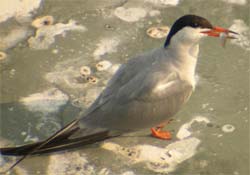
Figure 1. Common tern (Sterna hirundo) with a fish in its beak by the Grosse Ile, Michigan free bridge (Photo Credit: Bruce Szczechowski).
a (MDNR 2005). The common tern nested (Figure 2) on islands and along the shores of the Detroit River for hundreds if not thousands of years before disturbances led to a devastating population decline. Disturbances such as human encroachment (i.e., development), predation, effects of contaminants, and the explosive growth of ring-billed gulls on traditional common tern breeding grounds pose particularly acute threats to Great Lakes common tern populations. Also, the overgrowth of vegetation on the breeding grounds, especially by non-native, invasive species, has become an increasing concern. Common terns are indicators of ecological health because they are on the top of their food web, therefore susceptible to bioaccumulation of contaminants, such as PCBs, which cause reproductive failure. Common terns are also an excellent indicator species because they are longtime breeding residents of the Detroit River and their population has greatly fluctuated in response to environmental stressors.
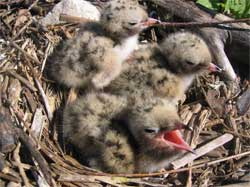
Figure 2. Common tern chicks (Sterna hirundo) in nest by the Grosse Ile, Michigan free bridge (Photo Credit: Bruce Szczechowski).
Status and Trends
In the 1960s, the lower Great Lakes had the largest recorded number of common tern nests when approximately 16,000 to 21,000 nesting pairs were observed (Nisbet 2002). By 1980, only approximately 5,000 pairs were recorded in the same region (Courtney and Blokpoel 1983). This decrease was due to many factors, including the increase of the ring-billed gull population. The ring-billed gull is an earlier spring-arriving species, opportunistic and readily adapts to human-altered habitats (Ludwig 1962). In the highly urbanized Detroit River watershed, the ring-billed gull population has increased 600-fold during the last quarter century (Weseloh et al. 2001).This has resulted in the displacement of common terns from formerly mixed gull-tern colonies in Detroit River, such as on Fighting Island (Figure 3). Although Fighting Island was once a productive tern colony, there have not been terns nesting on the Island since 1998. However, ring-billed gulls continue to successfully nest on the Island.
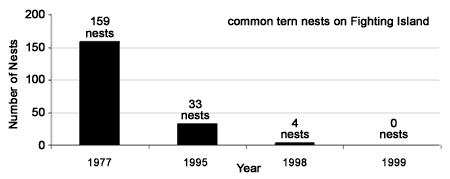
Figure 3. The number of common tern nests on Fighting Island, 1977, 1995, 1998 and 1999. Nests were counted in early to mid-incubation time (data collected by the Canadian Wildlife Service and Bird Studies Canada).
During years spanning 1960-1980, Courtney and Blokpoel (1983) documented over 4,500 common tern nests on Belle Isle and Mud, Grassy, Bob-Lo, and Fighting Islands in the Detroit River. In 2005 no terns were recorded nesting on the islands where they were historically located, and less then 300 common tern nests were found on two man-made bridge protection piers within the Trenton Channel of the Detroit River (Figure 4), representing a 98% decline in the last 25 years. Tern nesting habitat was created on the Grosse Ile Free Bridge protection pier in 2003 and has been utilized by nesting terns in 2004, and 2005.
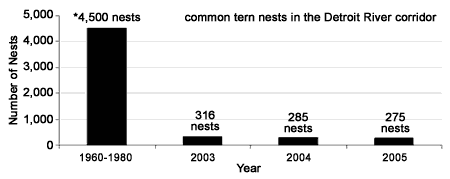
Figure 4. The number of common tern nests in the Detroit River corridor, 1960-1980 and 2003-2005 (1960-1980 population estimate from Courtney and Blokpoel (1983)*; 2003, 2004 and 2005 population estimates from Bull and Szczechowski).
Not only has the nesting population decreased, but it has been estimated in recent years that only about 20% of the chicks are making it to fledgling stage due to environmental factors, contaminant sensitivity, and predation, primarily by black-crowned night herons (Szczechowski and Bull 2005). In the Detroit River, nest and fledgling success is quantified before the midpoint of the nesting season (June 18th) because there is a much lower success rate during the second half of the nesting season. In 2005, eggs laid after the midpoint of the nesting season had approximately 24% hatch success compared to 62% before. The number of common tern nests has greatly decreased since the 1980s and terns have had moderate to poor fledge success in 2004 and 2005 (Table 1).
Table 1. Common tern hatch and fledge success (clutches completed on or before the midpoint of the nesting season, June 18th) near the Grosse Ile Free Bridge, 2003-2005 (data collected by B. Szczechowski and J. Bull).


In 2003 and 2004, common tern eggs were collected at the Grosse Ile Bridge nesting site, processed at the U.S. Fish and Wildlife Service lab, and sent to Great Lakes Institute for Environmental Research (University of Windsor, Ontario, Canada) for analysis of contaminants. PCBs found in tern eggs have greatly decreased in the 2003 and 2004 measurements compared to data collected by the Canadian Wildlife Service in 1972. Between 1981 and 2005, however, PCB declines have markedly slowed; there appears to have been a leveling off of PCB concentrations from 1991 to 2005 in common tern eggs from the Detroit River (Figure 5). Common terns are an excellent indicator species for tracking potential problems related to PCB contamination, since common terns are very sensitive to the dioxin-like toxic effects of PCBs (Nisbet 2002). Though common tern nesting success has been very low in recent years, it appears that the current PCB concentrations may play a secondary role to predation (and other factors) in diminishing common tern reproductive success in the Detroit River and elsewhere in the Great Lakes.
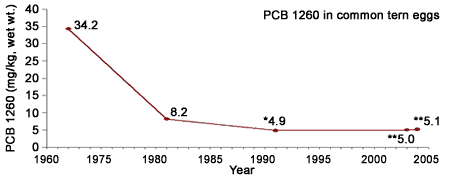
Figure 5. PCB 1260 trends in Detroit River common tern eggs 1972-2004
data for 1972 and for 1981 from Weseloh et al. 1989;
*concentrations in eggs collected on May 29, 1991 by Petitt et al. 1994;
**concentrations in eggs collected on May 6-8, 2003-2004 by Szczechowski and Bull. PCB levels are extrapolated from seasonal data to allow for comparison with 1991 data.
Management Next Steps
Common tern breeding habitat needs to be protected. Additional common tern breeding sites should be located and constructed, similar to the habitat on the Grosse Ile bridges. Terns prefer sandy, well drained areas away from mammalian predators and human disturbance, with enough space for colonies of 10 to 1,000 nests. Common terns also need an adequate population of small to medium-sized fish, such as shiners and chubs, and insects, such as dragonfly nymphs, as an essential food supply in close proximity to the nesting grounds. To ensure the future of the colony, 67% of eggs must hatch chicks which subsequently reach fledging stage (Szczechowski and Bull 2005). Predator control structures should be built to protect the vulnerable chicks to increase nest success.
Research/Monitoring Needs
Research with the Detroit River common tern colony at the Grosse Ile Free Bridge and Toll Bridge should continue, including monitoring the level of contaminants such as PCBs in common tern eggs. There should be additional research on methods to deter nest predation and other sources of nest failures. Research should also be conducted to determine the feasibility of re-establishing common tern nesting habitat on Fighting Island, Mud Island, and Belle Isle.
References
- Bishop, C.A., D.V. Weseloh, N.M. Burgess, J. Struger, R.J. Norstrom, R. Turle, and K.A. Logan. 1992. An atlas of contaminants in eggs of fish-eating colonial birds of the Great Lakes (1970-1988) Vols. I and II. Technical Report Series Numbers 152 and 153. Canadian Wildlife Service, Ontario Region.
- Courtney, P.A. and H. Blokpoel. 1983. Distribution and numbers of common terns nesting on the lower Great Lakes during 1900-1980: a review. Colonial Waterbirds. 6:107-112.
- Ludwig, J.P. 1962. A survey of the gull and tern populations of Lakes Huron, Michigan, and Superior. Jack-Pine Warbler. 40:104-119.
- Michigan Department of Natural Resources (MDNR). 2005. Common Terns (Sterna hirundo)(January 2006).
- Nisbet, I. 2002. Common tern: Sterna hirundo. The Birds of America No. 618. Birds of North America Inc. Philadelphia, PA.
- Pettit, K.E., C.A. Bishop, D.V. Weseloh, and R.J. Norstrom. 1994. An atlas of contaminants in the eggs of fish-eating colonial birds of the Great Lakes (1989-1992) Vols. I and II. Technical Report Series Numbers 193 and 194. Canadian Wildlife Service, Ontario Region.
- Szczechowski, B and J. Bull. 2005. Personal Communications.
- Weseloh, D.V., T.W. Custer, and B.M. Braune. 1989. Organochlorine contaminants in eggs of Common Terns form the Canadian Great Lakes, 1981. Environ. Pollution. 59:141-160.
- Weseloh, D.V., T. Havelka, and C. Pekarik. 2001. Biodiversity along the Detroit River Corridor: Changes and Prospects. State of the Strait Conference Proceedings, University of Windsor. Ontario, Canada.
Contact Information regarding Common Tern Reproduction
Bruce Szczechowski
Stream TeamE-mail: szczecho@sgate.k12.mi.us
James N. Bull
Detroit Audubon SocietyE-mail: mailto:jbull51264@aol.com
Emily Wilke
Southwest Michigan Land ConservancyE-mail: ewilke@swmlc.org